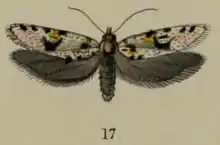Eurythecta robusta
Eurythecta robusta is a species of moth in the family Tortricidae. This species is endemic to New Zealand. It is classified as "At Risk, Naturally Uncommon" by the Department of Conservation.
| Eurythecta robusta | |
|---|---|
 | |
| Scientific classification | |
| Kingdom: | Animalia |
| Phylum: | Arthropoda |
| Class: | Insecta |
| Order: | Lepidoptera |
| Family: | Tortricidae |
| Genus: | Eurythecta |
| Species: | E. robusta |
| Binomial name | |
| Eurythecta robusta | |
| Synonyms[2] | |
| |
Taxonomy
This species was first described by Arthur Gardiner Butler in 1877 and named Zelotherses robusta.[3] Butler used specimens from James Hector that were collected on the Canterbury Plains.[3] Later in the same publication, thinking he was describing a separate species, Butler also named this moth Steganoptycha negligens.[4] In 1883 Edward Meyrick placed the species within the genus Eurythecta and synonymised both names given to the species by Butler.[5][2] George Hudson discussed and illustrated this species in his 1928 publication The Moths and Butterflies of New Zealand.[6] The lectotype specimen is held at the Natural History Museum, London.[2]
Description
Butler described the species as follows:
♂︎♀︎. Primaries sordid white, acute ; a broad oblique patch beginning just within the base of the discoidal cell and terminating in a point near to the centre of inner margin, a slender subcostal dash near the base, five spots on the apical half of costa, a squamose patch across the median veins, and the terminations of the nervures black-brown ; secondaries greyish, particularly towards the outer margin ; body sordid white : primaries below grey, the costal margin white, crossed by greyish spots towards apex ; secondaries paler grey, the costa white ; body below white. Expanse of wings 4 1⁄2 lines.[3]
Meyrick noted that the species is extremely variable in colour.[5]
Distribution
E. robusta is endemic to New Zealand.[1][7] The species has been found in North, Mid and South Canterbury.[8] The type locality of this species is likely Yaldhurst/West Melton in Christchurch and this area is now largely modified by the development of lifestyle blocks.[9] The species has occurred at Kaitorete Spit, Gore Bay, Porters Pass, McLeans Island, and has surviving populations at Ashburton, and at the mouths of the Rangitata and Hinds rivers.[9] Hudson stated that the species had been collected at Alexandra and Ben Lomond but there is some doubt as to whether this is the case.[6][9]
Biology and behaviour
The females of E. robust are flightless.[9] Adult males are on the wing from September until January.[9]
Host plants and habitat
The larvae feed on low mat-forming herbs and turf plants.[8] The favoured habitat of the species consists of open stony grounds[8] or coastal grassland habitat.[6][9]
Conservation status
This species has been classified as having the "At Risk, Naturally Uncommon" conservation status under the New Zealand Threat Classification System.[10] The main threat to this species is the destruction of its original habitat both by urban development and by farming practises.[9]
References
| Wikimedia Commons has media related to Eurythecta robusta. |
- "Eurythecta robusta (Butler, 1877)". www.nzor.org.nz. Landcare Research New Zealand Ltd. Retrieved 21 May 2018.
- Dugdale, J. S. (1988). "Lepidoptera-annotated catalogue, and keys to family-group taxa" (PDF). Fauna of New Zealand. 14: 1–264 – via Landcare Research New Zealand Ltd.
- Butler, Arthur G. (1877). "On two collections of Heterocerous Lepidoptera from New Zealand, with descriptions of new genera and species". Proceedings of the Zoological Society of London. 1877:May-Dec.: 379–407 – via Biodiversity Heritage Library.
- Butler, Arthur G. (1877). "On two collections of Heterocerous Lepidoptera from New Zealand, with descriptions of new genera and species". Proceedings of the Zoological Society of London. 1877:May-Dec.: 379–407 – via Biodiversity Heritage Library.
- Meyrick, Edward (1883). "Descriptions of New Zealand Microlepidoptera. I and II. Crambidae and Tortricina". Transactions and Proceedings of the New Zealand Institute. 15: 3–33, 33–68 – via Biodiversity Heritage Library.
- Hudson, G. V. (1928). The Butterflies and Moths of New Zealand. Wellington: Ferguson & Osborn Ltd. p. 224. OCLC 25449322.
- Gordon, Dennis P., ed. (2010). New Zealand Inventory of Biodiversity, Volume Two, Kingdom Animalia: Chaetognatha, Ecdysozoa, Ichnofossils. Vol. 2. Christchurch, N.Z.: Canterbury University Press. p. 464. ISBN 9781877257933. OCLC 973607714.
- Patrick, B. H.; Dugdale., J. S. (2000). "Conservation status of the New Zealand Lepidoptera" (PDF). Science for Conservation. 136: 23. ISBN 0478218672. ISSN 1173-2946. Archived from the original (PDF) on 1 May 2017. Retrieved 16 July 2014 – via Department of Conservation.
- Pawson, Stephen M.; Emberson, Rowan M. (2000). The conservation status of invertebrates in Canterbury (Report). Department of Conservation. p. 54. hdl:10182/1658. ISSN 1171-9834.
- Hoare, R.J.B.; Dugdale, J.S.; Edwards, E.D.; Gibbs, G.W.; Patrick, B.H.; Hitchmough, R.A.; Rolfe, J.R. (2017). "Conservation status of New Zealand butterflies and moths (Lepidoptera), 2015" (PDF). New Zealand Threat Classification Series. 20: 8.